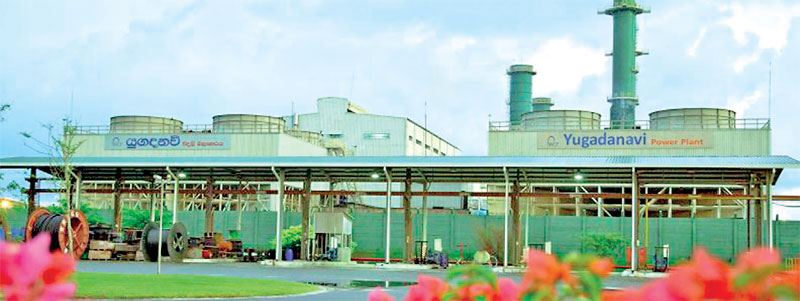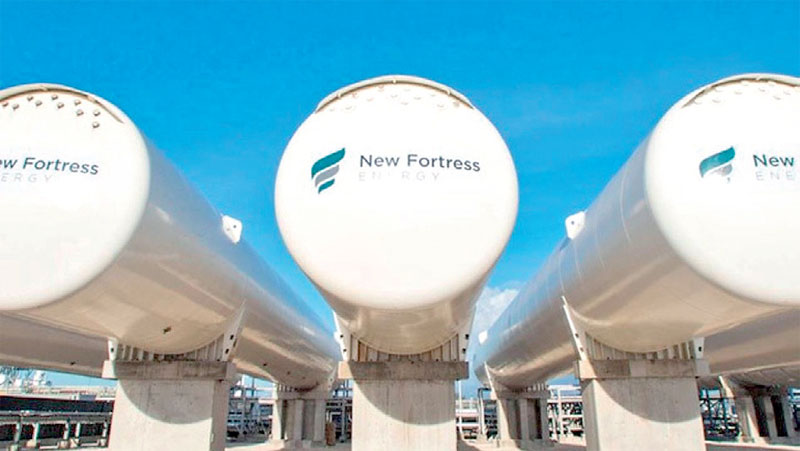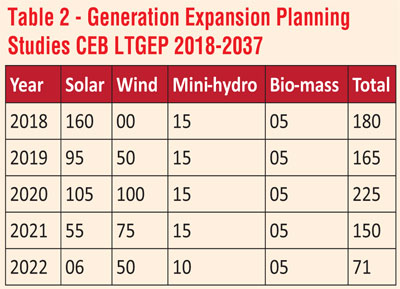Tuesday Jan 06, 2026
Tuesday Jan 06, 2026
Monday, 20 December 2021 00:33 - - {{hitsCtrl.values.hits}}


The President, by awarding the LNG supply to American company, New Fortress Energy Ltd., saved the country against CEB’s plans to demolish his vision for 70% renewable energy by 2030 and beyond
|
 The country is nearing a major electricity crisis, as CEB failed to implement any major power project since Norochcholai in 2015, although a number of tenders were called for electric power generation. The CEB’s latest tender to convert existing and future power plants into Liquid Natural Gas (LNG) stored in a Floating Storage and Regassification Unit and a pipeline system delivering gas to power plants.
The country is nearing a major electricity crisis, as CEB failed to implement any major power project since Norochcholai in 2015, although a number of tenders were called for electric power generation. The CEB’s latest tender to convert existing and future power plants into Liquid Natural Gas (LNG) stored in a Floating Storage and Regassification Unit and a pipeline system delivering gas to power plants.
Meanwhile, President Gotabaya Rajapaksa agreed to award the LNG supply to American company, New Fortress Energy Ltd., to supply LNG for the Yugadanavi Power Plant and the new 350 MW plant expected in two years. In addition, sale of 40% share of the Yugadanavi Power Plant for $ 250 million. The issue resulted in massive protests from CEB, public, and Opposition politicians. Also, some members of minor political parties within the Government. The agreement initiated by President Rajapaksa, it was claimed the relevant Cabinet Paper was not allowed proper discussion within the Cabinet, but the agreement was signed with the representatives of New Fortress Energy Ltd. around midnight and the NFE representative left the country around 2 a.m.
Allegations against NFE deal
A number of allegations are made against the NFE deal.
1. When CEB called worldwide tenders for the supply of LNG for the country’s power generation requirements, NFE failed to tender.
2. The deal includes purchase and supply of LNG, hire of a Floating Storage and Regassification Unit (FSRU) and delivery pipelines, all to NFE.
3. The country will depend solely on a single party and they could hold the country to ransom.
4. In addition, Minister Udaya Gammanpila expressed concerns that importing LNG would threaten development of Mannar Basin’s gas and oil reserves.
LNG and FSRU
LNG is a clear, colourless and non-toxic liquid formed when natural gas is cooled to -162ºC, shrinking the volume of gas 600 times, making it easier and safer to store and ship. In its liquid state, LNG will not ignite, but in the gaseous state, it is highly explosive and could lead to catastrophic environmental disasters.
When LNG reaches its destination, it is stored in a Floating Storage and Regassification Unit (FSRU). In the FSRU, the liquid is turned back into gas and piped to power plants where gas is burnt to generate electricity.
Government’s wish for a FSRU
The Government wishes to move over to LNG as a clean energy source, beyond coal and oil by installing an FSRU and will join other countries in the region. Solar power is unavailable during high consumption hours between 6:30 to 10 p.m., also during rains. LNG is expected to fill the gap until the country can afford battery storage, whose prices are expected to come down within few years.
Need for LNG
CEB was aware of LNG needs since 2007, when the LNG-based 300 MW Yugadanavi Power Plant contract was awarded, also run on diesel at a higher cost. But during the past 14 years, although a number of tenders were called, CEB failed to establish LNG supply. Also unsolicited proposals including a Korean investor were all dropped due to various reasons.
With the cancellation of the Sampur coal power project, CEB called tenders in 2016 for a 350 MW Kerawalapitiya Stage 2 based on LNG, expecting to deliver power by 2018. But the contract remains unawarded. The deficit is met with power from Private Power Producers at high prices whose purchase agreements ended long ago.
CEB’s tender for FSRU
CEB called tenders for an FSRU and delivery pipelines on 18 February 2021 which closed on 18 June. The document claimed ‘Not for Bidding’ available over the internet under ‘CEB, Request for Proposals for the Development of FSRU at Offshore Kerawalapitiya on BOO Basis and Mooring on BOOT Basis’.
The two tenders were, first for an FSRU to build, own and operate basis, and the second to build, own, operate and transfer basis. CEB itself would supply LNG to the FSRU.
The ‘Request For Proposal’ requires bidders to finance, design, procure, construct, commission, operate and maintain the facility. At the end of the operational period of 10 years, the mooring system will be transferred to CEB.
The tender documents were collected by 22 companies after paying the tender fee of Rs. 200,000, but only two proposals were received.
LNG requirement as per tender document
According to the tender document, LNG requirement was based on CEB’s Long Term Generation Expansion Plan for 2020-2039 for existing and proposed power plants as show in Table 1.
Country’s power requirements
According to CEB’s LTGEP 2020-2039 power requirement for every five years would be:
2020 3,050 MW
2025 3,903 MW
2030 4,872 MW
CEB tender envisages 1,933 MW of power through LNG or 39.7% of the country’s power requirement by 2030, completely contradicting the President’s target of 70% renewable energy by 2030, as existing coal power plants too would be operational.
New Fortress
Energy agreement
The Government’s agreement with New Fortress Energy Ltd., to supply LNG for 300 MW Yugadanavi Power Plant and the 350 MW power plant expected to come into stream in two years. Also, sale of 40% share of West Coast Power Ltd. owning Yugadanavi Power Plant for $ 250 million.
The company will procure LNG, store in a FSRU, construct necessary pipelines and deliver gas to two power plants, total capacity of 650 MW.
Comparison of tender and the offer
CEB tender includes three parts:
1. Procurement of LNG by CEB.
2. Supply and maintenance of a FSRU capable of delivering gas for 1,933 MW.
3. Laying and maintenance of a pipeline system to deliver gas to eight power plants.
Meanwhile, New Fortress Energy expects to supply 650 MW. Thus, CEB’s tender anticipates supply of almost three times that of NFE.
 Issues in an LNG-based system
Issues in an LNG-based system
Storage and supply of gas
Storing gas in a liquefied state is safe, the natural gas is piped from the FSRU via offshore and land pipelines. Unlike oil, gas leaks can lead to explosions in few seconds engulfing the entire region. Thus, gas pipelines are not allowed inside ports, or in populated areas.
The FSRU would be in the sea located off Kerawalapitiya, and could supply to power plants nearby. Under CEB tender gas is expected to be delivered to Kelanitissa and Sojitz power plants located near multiple Kelani Bridges, also most popular road from Colombo. When the public realises the dangers, it would never allow the pipeline. But the company who received the FSRU contract needs to be paid.
Completion of the project
When the contracted FSRU is delivered on time, normally within 24 months, it would cost around $ 120,000 per day. Under CEB tender the FSRU size is three times of NFE. Thus, the CEB tender’s FSRU would cost around $ 200,000 per day. When the FSRU is delivered on time, if there are any delays in construction of pipeline, with public protests, the Government would be forced to pay the FSRU for the unused system.
Meanwhile NFE would be responsible for the FSRU, pipeline operation and maintenance and not the GOSL/CEB. NFE is concerned with their global reputation worldwide and failures would impact their business opportunities.
 The Paris Agreement
The Paris Agreement
Sri Lanka signed the Paris Agreement for climate change in 2016, signed by 196 countries, aiming to limit the global climate increase to 1.5°C above per-industrial levels. The signatories agreed to undertake rapid reductions to achieve a balance between emissions and removals by mid-century. Thus, eliminating oil and coal powered plants and moving over to renewables as solar and wind power becomes urgent.
Promoting solar rooftop
The Sri Lanka Sustainable Energy Authority (SLSEA) with CEB introduced rooftop solar power units in 2010. At the beginning, producers were paid Rs. 23.10/kWh and this became a success, which led to Surya Bala Sangramaya or the battle for solar energy in 2016, with some private solar producers up to 5 MW. The program targeted 200 MW to the national grid by 2020 and 1,000 MW by 2025. The system was revised in August 2019 for rooftop solar producers up to 50 kWh being paid Rs. 19.75, while systems above 50 kWh were paid Rs. 18.75. By 2020-end 31,200 solar systems supplied 341 MW to the national grid. Since January 2016, CEB blocked all large solar projects. The Small Solar Producers Association protested that 617 prospective producers registered to produce up to 5 MW totalling 1,555 MW, already registered with SLSEA and having paid over Rs. 100 million were let down by CEB.
In June 2017, CEB called bids for 60 solar power plants of 1 MW capacity, to be connected to 20 grid stations. Out of 63 bids received, 36 were accepted under rates of Rs. 12.73 to Rs. 18.37 per unit, averaging Rs. 17.22.
Wind power plants
In 2010 SLSEA acceptance resulted in 15 wind power projects producing 127 MW by 2014 from six companies, 10 exceeding 10 MW each. Of them Hayleys installed two projects totalling 30 MW. But no further wind power plants were allowed, claiming corruption.
In November 2019, CEB called request for proposals for the establishment of 1 to 10 MW wind power plants totalling 60 MW on BOT basis bids closing in February 2020, overlooking that existing privately owned wind power plants were mostly over 10 MW.
 CEB engineers sabotaging solar and wind power development
CEB engineers sabotaging solar and wind power development
CEB’s acceptance law
Under the Electricity Act No. 31 of 2013, any generation unit connected to the grid needs approval of CEB, and also should conform with CEB’s Long Term Generation Expansion Plan. The Act also allows accepting projects selected after calling for tenders. CEB engineers misinterpreted the Electricity Act delaying and stopping projects recommended by the SLSEA.
According to an SLSEA report dated 27 March 2019, several RE projects submitted by investors and approved by SLSEA since 2016 were held up as CEB has refused to sign the power purchase agreements.
CEB engineers were able to place limitations and restrictions on acceptance of solar and wind power projects based on Table 2.
Table 3 shows how CEB engineers manipulated renewable production by including low carbon even beyond 2022, to a maximum of 389 MW per year. These in spite of the President’s vision of 70% power generation through renewables by 2030.
Few days ago, CEB called tenders for 800 solar projects of 75 kw capacity from private developers, tenders closing on 18 January 2022. Earlier developers tendered for projects over 10 MW, another manipulation by CEB.
Recovery of gas and oil from Mannar
The Minister of Energy Udaya Gammanpila is concerned that the supply of LNG by New Fortress Energy will disturb recovery of oil and gas from Mannar. The Minister claims that $ 267 billion worth oil and gas are hidden in Mannar Basin.
Cairn discovered two gas fields in 2011, 30 and 60 km from the shore in water depths of 1,354 m and 1,509 m. The 24 m thick gas-bearing sandstone was found at 4,741 m depth with the potential of over two billion barrels of oil and nine trillion cubic feet of natural gas. But the commercial viability is considered 30 to 40%.
The development of fields at 4.7 km depth is extremely costly and would require a third-party verification, an expensive exercise to be borne by SL. Oil extraction requires mobilisation of a drilling ship, deep-water drilling and when oil/gas discovered an FSRU to collect the gas. All these heavy expenses need be shared at agreed percentages and paid monthly in Dollars. Does the country have sufficient finances acceptable to gas companies?
The Paris Agreement had led to a situation worldwide, reducing future demand for oil and gas. Major oil companies fear with the lowering of demand, they would be saddled with massive oil and gas reserves without buyers. Under these realities and the country’s finances, the Minister’s dream of Mannar gas would remain only a dream.
Discussion
The New Fortress Energy company deal was promoted to President Rajapaksa by former US Ambassador Alaina B. Teplitz. The first major deal with Sri Lanka alters several decades; US ambassador with their government took pains to propose a very favourable deal to Sri Lanka, to the extent in a payment failure by SL, US Government will settle the dues to NFE. The company with major LNG resources under its belt, was able to offer an attractive deal.
Under the CEB’s tender, it would purchase and supply LNG to produce 1,933 MW to eight different plants, nearly three times the WCP offer. The FSRU contractor could deliver the ship on time and when there are delays in pipelines due to public protests or any other, the CEB will be forced to pay FSRU rentals up to nearly $ 200,000 per day.
In the New Fortress Energy deal, the entire contract is by a single contractor and if delayed no payments would be due.
The CEB tender expects delivering LNG to Kelanitissa and Sojitz plant near Kelani River and multiple Kelani Bridges, also the pipeline route would pass through populated areas. If the pipeline develops a leak, it would be highly explosive and could lead to a catastrophic situation; nowadays gas explodes in kitchens, how about a pipeline. Showing CEB engineers’ lack of knowledge on LNG?
CEB engineers with the tender were interested in supplying LNG similar to coal to make money. In addition, they wished to sabotage future development of renewable energy as shown in their 2022-2041 plan (given in table 3). They manipulated the President’s vision by claiming ‘70% Low Carbon by 2030’.
During 2016 to 2020, CEB effectively obstructed over 1,500 MW of solar and wind power projects producing electricity at less than Rs. 12 a unit. If allowed, most oil-based power plants could have been retired by now, saving a massive amount of foreign exchange averting the current financial crisis.
The President, by awarding the LNG supply to American company, New Fortress Energy Ltd., saved the country against CEB’s plans to demolish his vision for 70% renewable energy by 2030 and beyond.
During the past two years ministers, secretaries and chairmen failed to control the CEB and the country continued to be dragged down.
The President needs to take over CEB and push for renewables, awarding larger solar and wind power contracts to local investors based on tendered rates received few years ago, adjusted for Dollar depreciation. In addition, foreign investors too could be allowed larger plants on negotiated rates. Accelerated renewable generation will allow a majority of high-cost oil-based power plants to be retired with cheaper electricity from solar and wind power.